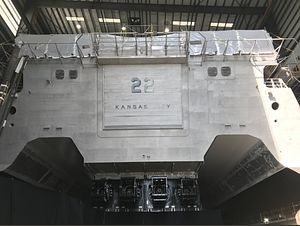The U.S. Navy christened its latest littoral combat ship (LCS), the future USS Kansas City (LCS 22), during a ceremony at the Austal USA shipyard in Mobile, Alabama on September 22. The ship, which was laid down in December 2o17, is the eleventh of the Independence-class variant and the 22nd LCS overall. It is expected to be commissioned in late 2019 following extensive acceptance trials.
LCSs are divided into two separate classes, the Independence and Freedom variants. Construction of the Freedom-class variant is overseen by Lockheed Martin at Fincantieri Marinette Marine shipyard in Wisconsin, while construction of the Independence-class is spearheaded by Austal USA in Alabama. As I noted earlier this year:
The Independence-class LCS features a trimaran hull and a larger flight deck than the Freedom-variant design, enabling Independence-class ships of this particular variant to carry two rather than one SH-60 Seahawk helicopter, or one larger Ch-53 Sea Stallion helicopter, next to a number of unmanned aerial vehicles. Furthermore, the Independence-class also has a larger fuel capacity and a wider operational range.
Furthermore, I explained:
Using an open architecture design, both LCS classes — the mono-hull Freedom and trimaran-hull Independence variants — are modular, reconfigurable warships that can be fitted with interchangeable mission packages providing specific capabilities for surface warfare (SUW), anti-submarine warfare (ASW), and mine countermeasures (MCM) missions in the littoral region.
Standard armaments of both LCS variant consist of a 57-millimeter naval gun, 11-cell Raytheon RIM-116B SeaRAM missile-defense system, and Mark 5o light-weight torpedoes launched from torpedo tubes. LCSs are also expected to be fitted with the so-called Surface-to-Surface Missile Module, a 24-shot vertical launch system designed to engage smaller surface targets in close proximity to the LCS with AGM-114L Longbow Hellfire missiles with initial operational capability expected by the end of 2019.
Notably, the ASW warfare package is slated to become available next year, and the MCM package by 2020. The ships are also not suitable for high-intensity combat against the navies of a near-peer competitors, according to a January 2018 report by the Pentagon’s office of Operational Test and Evaluation:
Survivability testing and preliminary analyses on both LCS variants continue to demonstrate that neither LCS variant is survivable in high intensity combat. Although the ships incorporate capabilities to reduce their susceptibility to attack, testing of analogous capabilities in other ship classes demonstrated that such capabilities have limited effectiveness in high intensity combat.
The U.S. Navy accepted delivery of two Freedom-class LCSs — the future USS Sioux City and USS Wichita — at the Fincantieri Marinette Marine shipyard in Wisconsin in August.
The future LCSs 32 and 34— the sixteenth and seventeenth Independence variants — were awarded to Austal USA on September 18, 2018. Notably, while 11 LCSs have been commissioned to date, not a single ship of the class has been deployed in 2018.

































